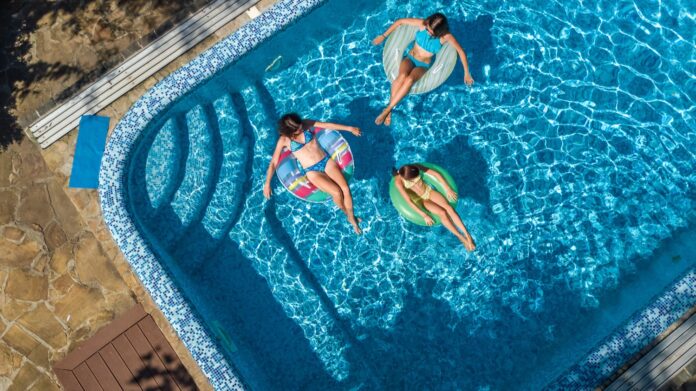There are several ways to fill a swimming pool with water. Depending on your choices (and your possibilities!), the costs are very variable. To help you see more clearly among the options available to you, here are the most common ways to fill your swimming pool.
City water
The most classic way to fill a pool is to connect a garden hose to an outside faucet and fill your pool that way.
- Cost: Since January 1, 2021, the total price per cubic meter of water is €3.45/m3 including tax excluding subscription.
- Time: Allow between 24 and 48 hours to fill your pool, depending on its size.
Well water
If you have a well in your yard, you might consider drawing water from it to fill your pool. Just be sure to check the capacity of your well to make sure you have enough water for your pool.
- Cost: As you might expect, this method is the most affordable. However, it does involve some risks. First, your pump and/or softening system may cost money because of the extra work involved. Second, if you have overestimated the capacity of your well, it could dry up.
- Time: Using well water takes about as long as using a garden hose, but it also depends on the capacity of your pump. A good pump can save time.
- Considerations: City water is typically tested and pre-treated for hardness, mineral content, and other elements before being delivered to homes. Well, water is often much harder than city water, with lots of minerals, sulfur, and other elements that you don’t want in your pool. This can make it very difficult to balance your pool water.
Pro Tip: Discover the Best Water Purification Systems in Glendale, AZ! Ensure safe, clean, and freshwater for your home. Call today for expert installation and top-quality products.
Swimming pool water delivery service & fire hydrants
Water delivery by tanker truck is very common in the United States and Canada, but very little in France. It is therefore not a solution that is considered in our beautiful country. Regarding firefighter services or the use of a fire hydrant, be informed that these practices are strictly prohibited by law.
Before starting the filling
As you can see, you only have two options for filling your pool: city water and well water. But whatever filling method you want to use, here are some precautions to take before you start.
- Inspect the shell or line of your pool, this is the ideal time to avoid unpleasant surprises caused by a leak!
- Smooth out the wrinkles, you won’t be able to do it again when your pool is full!
When should you fill or recharge a swimming pool?
All pools need occasional topping up, to compensate for evaporation and splashing. Some professionals also consider that a pool should be emptied every 2-3 years.
How to Reduce Water Loss in a Swimming Pool
Filling a pool takes time and costs money! So if you want to enjoy it for as long as possible and save money, you’ll probably want to reduce water loss as much as possible! Here are some ways to keep all the water in your pool where it belongs, in the pool.
Reduce evaporation
Evaporation can reduce your water by about 2 cl per day! However, there is a quick way to reduce this phenomenon, by covering your pool with a blanket. And if you want to be smart, you can even opt for a heated blanket!
Maintaining your water balance
Proper maintenance of your pool will prevent you from having to empty it in the event of a problem!
Pro Tip: Get the Best Water Purification Systems in Phoenix, AZ for pure and healthy water. Expert installation and top-notch solutions for your home. Contact us now!
How to know if you have a leak
While evaporation and splashing are normal, it can be difficult to tell if your pool leaks. Here’s a quick test:
- Take a large waterproof bucket, ideally with transparent or opaque sides that you can see through
- Place the bucket on the steps of your pool, partially submerged in the water. You will probably need to weigh it down with a brick to keep it in place.
- Fill the inside of the bucket to the same water level as the pool water outside the bucket
- Mark the water level on the bucket
- Leave it for 24 hours, with the pool pump running normally
- If you come back the next day and the water level inside the bucket is higher than the water level in the pool, you may have a pool leak.
- Repeat this test with the pool pump off for another 24 hours to be sure.
If you have a leak in your pool, it is important to fix it immediately. Not only are leaks costly, they can damage your pool or garden.



